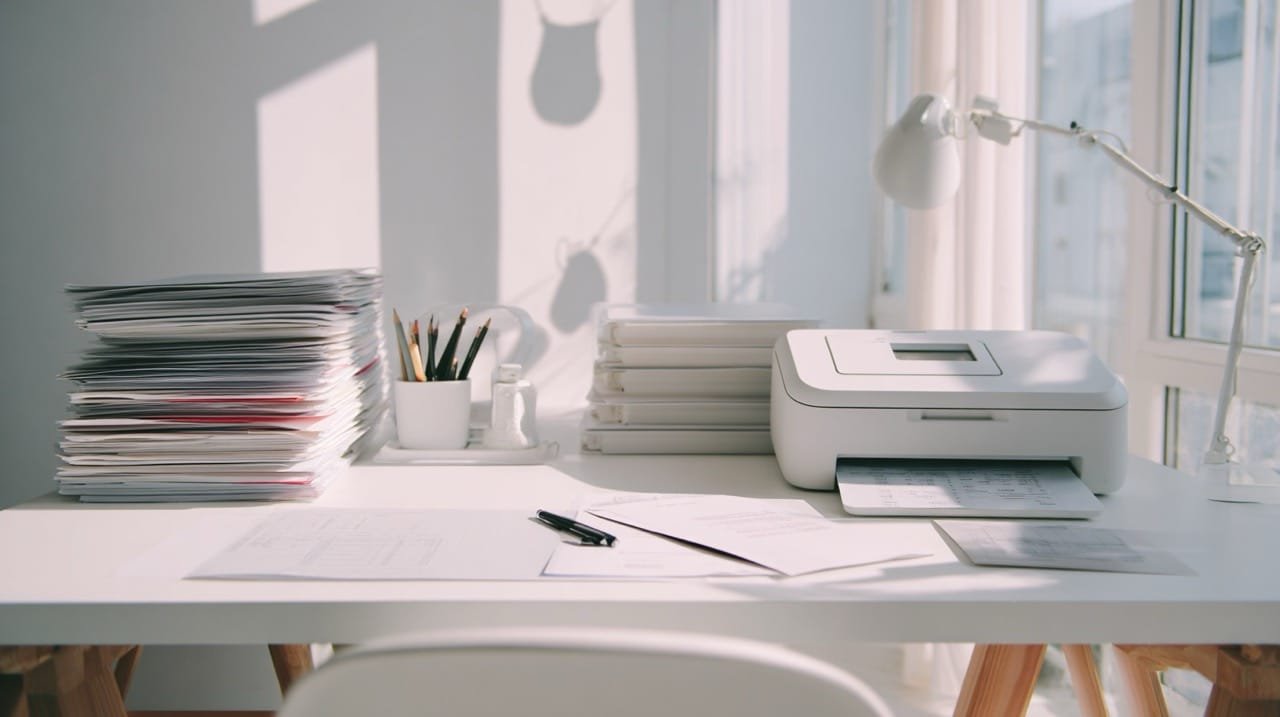Table of Contents
Why Even Bother With Digital Organisation?
Chaos is the final boss of productivity, or as Marie Kondo once put it, “clutter is a magnet for misery.“
In her book Joy at Work, the popular tidying expert demonstrates how disorder reigns at our workplaces, not just physically, but digitally as well.
How many hours do we waste searching for a missing file in our Google Drive folder or scouring our entire inbox for a client’s letter, only to remember they sent it via WhatsApp?
There was a time when I communicated with one and the same client via five different channels: email, Signal, SMS, Slack, and Instagram direct messages. I kid you not. It drove me bananas how they’d resume conversations in a different channel all the time.
It’s almost impossible to work efficiently when your digital life is that scattered. Worst case scenario: it contributes to feeling digitally burnt out.
Get Organised With Digital Minimalism
Digital clutter has proven effects on our health, productivity, and overall wellbeing. What’s the workaround? I’ve been a fan of taking the digital minimalism approach for some time now. Popularised by American author Cal Newport, this philosophy is based on three principles:
You don’t have to become a digital minimalist, of course, but there’s a high probability that you could at least benefit from a digital spring clean (and maybe even a detox from the internet?). Here’s how to organise your digital life effectively. All of these things have worked well for me!
Decluttering Your Digital Space
Begin your digital organisation with an audit, a sort of inventory of all the apps and software you use. If you want to get really granular, you could make a note of them in a sheet and answer the following questions:
You don’t have to go to the trouble of creating an elaborate spreadsheet, but at the least I recommend making a note of anything you’re paying for on a recurring basis so that they stay on your radar.
Delete the Digital Clutter That Doesn’t Serve You

Look through your list and be honest with yourself. Is the desktop design app that costs £5 a month but which you only use once a quarter really worth it, or could you be using Canva to do what it does?
Do you absolutely need a paid tool for automatically posting your social media content, or is the free Meta Business Suite sufficient?
Couldn’t you store your many files in just one cloud storage solution, or do you need both Google Drive and Dropbox?
Being ruthless about removing unnecessary digital tools sets a good stage for better digital organisation. Each app or service you eliminate means fewer places to check, fewer passwords to remember, and a more streamlined digital life.
Create a Clear Folder Structure
The foundation of digital organisation is a logical folder system that makes sense to you. Create main folders for broad categories (like “Work,” “Personal,” “Finance”) and then use subfolders to organise more specifically. For example, within “Work,” you might have subfolders for each client or project, and within those, additional subfolders organised by date or project phase.
When you’re going paperless, scan your documents right into your folder hierarchy.
Design your folder hierarchy to match your thinking patterns. For instance, if you typically think “That was from the weddings we went to from Sam’s side of the family,” yu might prefer to organise your photos by event first, then by date, rather than sorting everything chronologically.
Tag and Organise Your Digital Files
After digital downsizing, you’ll want to think about how you can organise digital files as efficiently as possible. Develop your own SOP, a standard operating procedure, for filing. This is essentially just a consistent system you’ll follow every time you save or re-organise files.
A well-structured filing system usually includes both logical folder structures and a bit of strategic tagging. Tags allow you to find similar files across different folders without having to remember exactly where you stored something. For example, you might tag all tax-related documents with “taxes” regardless of whether they’re in your business expenses folder or personal finance folder.
When creating your organisational system, think about how you naturally search for information. Do you remember files by date, by project, or by content type? Design your folder structure and tagging system to match how your brain naturally categorises information! This makes your digital organisation intuitive rather than something you have to consciously remember.
Going back to Cal Newport, what distinguishes digitally organised people, he says, is that they know exactly when, why, and what they use a tool for. For instance, rather than saying “I use cloud storage for my computer files,” they tend to be more specific: “I store current projects in Google Drive with consistent naming patterns, while completed projects get archived to my external hard drive at the end of each quarter.”
Revisit your inventory of apps and define specific purposes and usage patterns for each. Taking an intentional approach like this can help transform vague digital habits into a more structured system that prevents digital clutter from accumulating in the first place.
Files Names for Easy Retrieval
You can apply the same organising principle to your work processes and workflows. When I was the localisation director of a social media network, I developed SOPs for how we handle translation pipelines and editorial schedules, how the team communicates on Asana and Slack, and also how international press coverage is tracked and monitored so it can be found again later by anyone who needs to reference it.
These days I’ve also established naming conventions for my consultancy’s documents. This includes consistent file names that make it easy to find important files when needed. For example, all client documents follow the pattern “ClientNumber_YYMMDD_ProjectNumber_FileName” which helps me better organise both alphabetically and chronologically per client, and quickly find the files I need.
8 Digital Organisation Tips to Take Away

Establishing good digital organisation takes a bit of prep time but pays off enormously in productivity gains. The systems I devised for myself many years ago have stuck and continue to save me time and stress today.
Stack the following micro-strategies onto your new system and you can build upon the above-mentioned principles for even more control of your digital environment:
- Set aside five to ten minutes each week to sort and file new digital documents
- Create subfolders with logical structures that mirror how you think about your work
- Use cloud storage strategically for important documents that need backup
- Regularly delete old files you no longer need to free up storage space
- Use a browser tab extension to organise frequently visited websites
- Tag similar files to help keep everything findable across folder structures
- Establish a consistent filing system for emails and digital receipts
- Consider using organisational tools like Devonthink or Evernote for quick access to important notes
The key to maintaining a well-organised digital space is really just having a good system you can consistently stick to. I’ve found that having even a basic system that I actually use beats an elaborate one that gets ignored. When you find an approach that works with your natural habits, digital organisation becomes less of a chore and more of a helpful framework that quietly supports your productivity in the background.











Leave a Reply